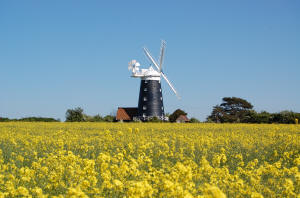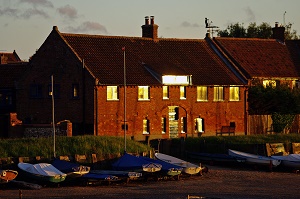Crossley-Holland is also a prolific children's author
and many of his stories are influenced by East Anglian folk
tales e.g. The Pedlar of Swaffham (1971) and Black
Shuck. His work as an
Anglo-Saxon scholar has also been an influence and can
be seen in his translation of Beowulf.Crossley-Holland was one of the founders of the Wells
Poetry Festival - an annual event held in the nearby
town.
The novelist and playwright Patrick Hamilton
(1901-62) lived in the village during the 1930s while
working on The Siege of Pleasure. During this
time his wife, Lois Hamilton, banned him from the local
pub - The Hero - which was close to their cottage but
she did allow him occasional pints in The Lord Nelson at
Burnham Thorpe and The Ostrich at South Creake.
Hamilton had a close
association with the North Norfolk coast and also lived
at Highfield House at Blakeney
and Long Acre at Cley before
moving to a flat in
Sheringham at Martincross.
He died
of an alcohol-related illness in 1962 and his ashes were
scattered at Blakeney Flats.
Henry Sutton's novel Bank Holiday Monday
(1996) is set at Burnham Overy Mill. Sutton, who was
born at Hopton, has also used
Gorleston as a location for one of his novels.
Despite these local links, Sutton has been quoted as
saying: 'I wouldn't say I am a Norfolk writer. It's the
relationships between people and the fine details that
interest me, first, not the place itself.'

Burnham Overy Windmill
Burnham Overy Staithe also provided the inspiration
for Joan G. Robinson's (1910-88) beloved children's book
When Marnie Was There. The story, first
published in 1967, concerns a lonely orphan girl called
Anna who travels to the Norfolk coast in order to
recover from an illness. Here she has various adventures
and ends up meeting the elusive Marnie who lives in the
Marsh House. The house which inspired the Marsh House
actually exists and is known locally as the 'house with
blue windows'.

The Marsh House by @Scullridge
The story has subsequently been turned into a highly
successful animated film by the Japanese Studio Ghibli.
There are six Burnham villages in all: Burnham
Market, Burnham Thorpe, Burnham Norton, Burnham Deepdale,
Burnham Overy Town and Burnham Overy Staithe. Nelson was
born at Burnham Thorpe in 1758 and it is likely that he
learnt to sail in Burnham Creek. Today, houses in the
area are highly sought after by 'wealthy folk' from
London and hence why it's often known as
'Chelsea-on-Sea' or 'Burnham Upmarket'.
|

